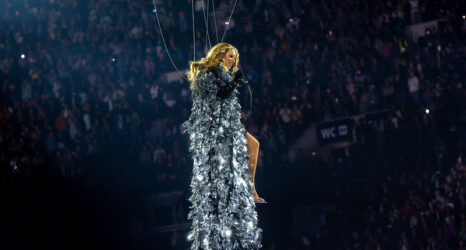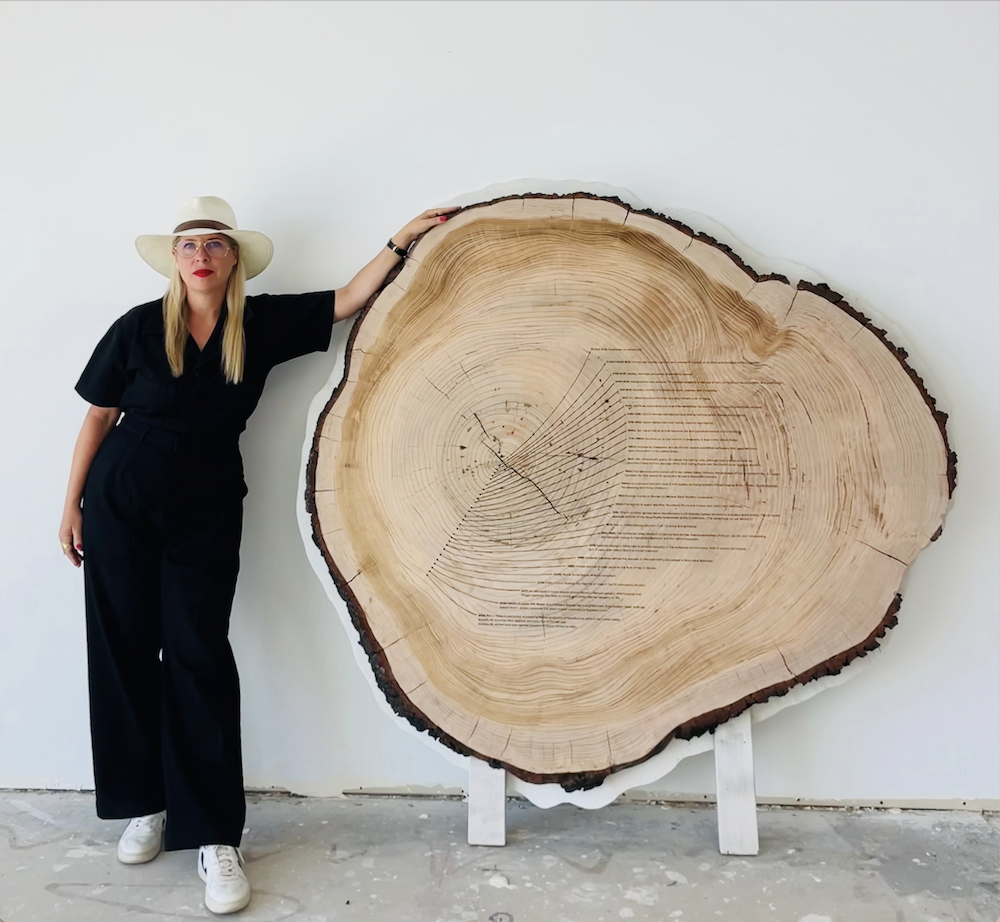Though the women are solitary in Elizabeth Malaska’s When We Dead Awaken II, they are not alone. Instead, each appears to be many women at once, composed of multiple figures, a kind of palimpsest. Here, the wrecked bodies of women–those seen daily, cut up in advertisements and magazine pages and newspapers and crime dramas and high art’s canvases–have been reassembled, stitched, repaired. Wild-haired, many-armed, the women triumph. No matter what happened before, no matter who used to dominate these spaces, the painted worlds belong to Malaska’s women now.
[stackerdecks_id]MzBzNTI5OA==[/stackerdecks_id]
Malaska marks the spaces as her subjects’ in part by skewing perspective. The grate in No Man’s Land on which sits a woman and a hawk may be horizontal or it may be vertical or it may be a textile and not a grate at all–yet the figure resting on it with her camouflaged gun understands how it works and will not fall. The ambiguity of the grate destabilizes the room, renders it volatile, mysterious. “A ripple happens because of imprecision,” Malaska told me when we met in her studio. Malaska’s careful work throughout this series–the gridded walls and bricks and stairways–remind the viewer that the ripple is not accidental.
Malaska troubles certainty intentionally, glitching these works. In every painting, the viewer can find places where things don’t line up, cracks, a gap between hips and torso, a broken forearm, hair flying away, a leg with no foot and missing its shoe. These moments of rupture rend the surface of the canvas and bring into view the act of looking itself. As a result, the paintings cannot be easily consumed because you can never be sure what you see is all there is to see; your perspective could be wrong. Malaska’s canvases perform a necessary political critique of the gaze at a time when hegemonic vision—drones, war, police brutality, sexism, racism—continues to kill.
In The Queer Art of Failure, Jack Halberstam argues that failure, unbecoming, and refusal are the only viable forms of resistance left for those working against oppressive systems. Everything is compromised, Halberstam argues; if freedom was defined against slavery, then “freedom” itself is suspect – and it must be refused and reimagined. One of the questions driving Halberstam’s work drives Malaska’s, too: Can “freedom be imagined separately from the terms upon which it is offered?” While Halberstam would answer this question in the negative, I think Malaska would answer in the affirmative—and her attempt to reimagine freedom is visible in When We Dead Awaken II. Malaska has taken on the fraught feminist challenge of painting women without objectifying women. It is as if Picasso’s models have come to life—perhaps they are Malaska’s awakened dead?— marching out of his canvases in protest and into hers. She employs both formal and content-based strategies to grant her subjects agency and to disrupt the viewer’s gaze. I will highlight three strategies here: juxtaposition, collage, and unbecoming.
First, juxtaposition. In Fred Wilson’s “Metalwork, 1793-1880” (part of Mining the Museum at the Maryland Historical Society in 1992), silver urns and cups and vessels are displayed next to slave manacles. Wilson’s juxtaposition makes the violence of slavery visible in a way that displaying either manacles or silver alone could not. Something similar happens when Malaska juxtaposes her painted figures with classical sculptures. The proximity of the two kinds of bodies – a painted woman, a painted sculpture – raises questions about representations of female forms. Viewers have been trained to think nothing of the partial bodies pedestaled in museums, missing heads and arms and legs, as if all that matters is the torso, which could be any body, there to be admired, objectified, owned. By painting women with an abundance of body parts next to these broken bodies, Malaska changes the meaning of the sculptures they share the space with.
Second, collage. The walls of Malaska’s studio are pinned with collages – magazine pages and art and photographs that she has cut apart, taped together, and redacted. Malaska paints from these constructed images and leaves evidence of the collaged nature of the source material in her paintings. For Halberstam in The Queer Art of Failure, collage is “a revolutionary statement of pure opposition” that “speaks the language of refusal.” Pointing to Yoko Ono’s Cut Piece and Kara Walker’s collaged silhouettes as examples, Halberstam argues that collages maintain “a constant tension between the elements of the work,” asking the viewer to consider not just productive power, but negative power – the “power to unbecome.” In Malaska’s Cut Piece (named after Ono’s performance), it is as if not only the clothing has been cut apart, but the body, too, and Malaska has left the rifts visible so it is not quite clear whether this is a body coming undone or coming together. And this, it seems, is the point – to highlight the difficulty of becoming “woman,” even in the painted rooms where patriarchy has failed.
Third, unbecoming. In The Queer Art of Failure, Halberstam calls for a “feminist politics that issues not from a doing but from an undoing, not from a being or becoming women but from a refusal to be or become woman as she has been defined and imagined within Western philosophy.” The figures in Malaska’s paintings are unbecoming; they (literally) come undone, and they do not conform to expectations of femininity (unseemly, inappropriate). They rebel against the “tyranny of nice,” the gendered and raced behaviors women are socialized to perform. The mismatched collaged bodies, the figures’ authoritative stances, the glitches, the weapons, the hidden faces and mysterious doorways and vessels – all reflect a kind of refusal to conform, to perform, to be what hegemony requires.
One canvas has no women in it. Who Weeps For You contains a dog, a sculpture, and an urn in a tiled room. I can think only of the torture photographs taken at Abu Ghraib prison in Iraq. The sculpture, whose head seems to have been sprayed with silly string, is the only male in this series. It is not clear whether he represents the torturers or their victims, and it is not clear whether the torture has ended or continues here and in rooms just like this one, tiled so the blood is easier to clean. The inclusion of this painting in Malaska’s show casts the shadow of our long wars on the other paintings, linking the violence of sexism, imperialism, and racism, the material effects of mis-seeing. The painting titled Not to Pass On Tradition, But to Break its Hold Over Us (the Archive and its Shadow) alludes to this shadow, to what Allan Sekula calls “a shadow archive,” defined as the historical reservoir of images that (mis)shape how viewers see (and do not see) other images. In an article about the Abu Ghraib torture photographs, Joseph Pugliese refers to shadow archives the “visual conditions of possibility” that underpin images of violence and render them intelligible. In other words, images of violence make future violence possible – politics are enabled by aesthetics. What we see shapes what we do; and what we do shapes what we see.
Malaska told me she paints the “ruins of a failed world,” and her painted ruins are enchanting. This is an artist who loves to paint. Spray paint and oil and acrylic. Pink rugs and curtains. Potted plants and crocheted bikinis and ghosted cats. Lace and quilts and stained glass. The work is thick with imagination and joy and possibility. When We Dead Awaken II is, in Halberstam’s words, a “negative destruction” that “nonetheless refuses to relinquish pleasure.”
In Some of Us Did Not Die, a woman sits on a pastel quilted blanket – pink and blue and yellow and purple, hearts in its corners – her dark hair piled on her head, grey hair falling in her face, two arms by her sides, a third raised in a defiant fist, her eyes looking out as if she could look through the viewer to the world that will come next, the world she and the other women in these canvases will make, the world Malaska will paint.





